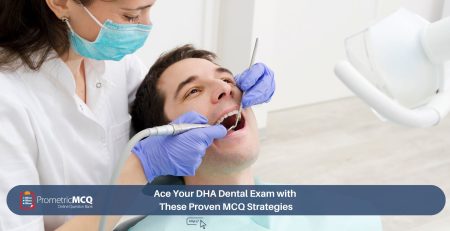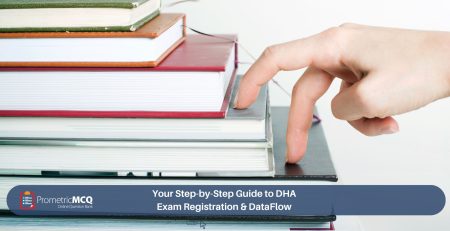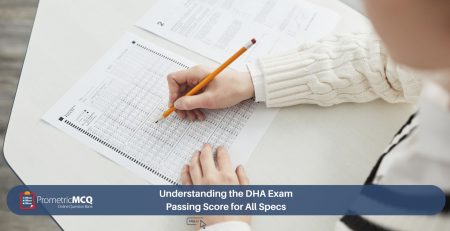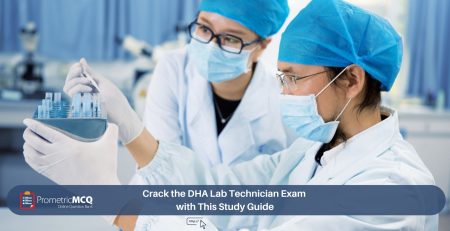
OMSB Oman Prometric Exam for Doctors: MCQ Prep 2025
fatima@prometricmcq.com2025-09-24T16:11:24+00:00Table of Contents
ToggleOMSB Oman Prometric Exam for Doctors: MCQ Prep 2025
The Sultanate of Oman, with its rich history, stunning landscapes, and a rapidly advancing healthcare system, has emerged as a highly attractive destination for medical professionals globally. The Oman Medical Specialty Board (OMSB) is the national body entrusted with upholding the highest standards of medical practice, and its licensure examination is the critical gateway for all doctors wishing to practice in the country. This exam, administered by Prometric, is a rigorous test of a physician’s clinical competence, knowledge, and decision-making abilities.
Success on the OMSB Prometric exam is not about rote memorization of textbook facts. It is a sophisticated assessment designed to evaluate how a doctor thinks. The exam is built around clinical vignettes—real-world patient scenarios that require you to synthesize information, formulate a differential diagnosis, and determine the most appropriate course of action. Mastering the content is essential, but mastering the art of Multiple-Choice Question (MCQ) analysis is what truly separates a pass from a fail.
This ultimate 2025 guide is your comprehensive blueprint for conquering the OMSB exam for doctors, particularly General Practitioners. We will provide a meticulous breakdown of the exam pattern, a deep dive into the high-yield syllabus topics, and a series of realistic sample MCQs with detailed, evidence-based rationales to sharpen your clinical reasoning. Complemented by a 10-point FAQ section, this guide is designed to provide clarity, direction, and the confidence you need to excel in your exam and secure your Oman OMSB license.
Key Takeaways for OMSB Exam Success
- Clinical Scenarios are Everything: The entire exam is based on clinical cases. Your ability to analyze a vignette and make a sound clinical decision is the core skill being tested.
- Internal Medicine is the Foundation: A significant majority of the exam questions for General Practitioners are derived from Internal Medicine and its subspecialties.
- Evidence-Based Guidelines are Key: Your answers must reflect the latest international, evidence-based medical guidelines (e.g., for managing hypertension, diabetes, ACS).
- Master the “Next Best Step”: Many questions will not ask for the final diagnosis but for the most appropriate next step in investigation or management.
- High-Yield MCQ Practice is Mandatory: The most effective preparation strategy is to solve thousands of high-quality MCQs to master the content, timing, and question style.
Deconstructing the 2025 OMSB Prometric Exam Pattern
A successful study plan starts with a thorough understanding of the exam’s architecture. The OMSB exam for doctors follows a standardized international format, making the preparation process predictable for those who know what to look for. This is a crucial first step in your overall OMSB Oman Prometric Exam preparation.
1. Test Administrator and Format
The OMSB partners with Prometric to administer its exams globally. The test is a Computer-Based Test (CBT). For General Practitioners, the exam typically consists of 150 MCQs to be completed in 3 hours (180 minutes). This structure demands efficient time management, allowing an average of just over one minute per question.
2. Scoring System
The exam result is a simple Pass or Fail. OMSB does not provide a numerical score or percentage. The unofficial passing threshold is generally considered to be in the range of 60% to 65%. Importantly, there is no negative marking, so you must answer every single question.
3. Question Style: The Clinical Vignette
Expect every question to be a short clinical case. You will be provided with a patient’s demographic information, presenting symptoms, relevant medical history, physical examination findings, and often laboratory or imaging results. You must then choose the single best answer from four or five options.
High-Yield Syllabus for the OMSB General Practitioner Exam
The scope of general practice is vast, but the OMSB exam focuses on common and critical conditions that a competent GP is expected to manage. A strategic study plan prioritizes these high-yield areas.
| Core Medical Domain | High-Yield Topics and Key Concepts for 2025 |
|---|---|
| Internal Medicine (Approx. 50-60%) | This is the most heavily weighted section. Cardiology: Management of Hypertension, Acute Coronary Syndrome (ACS), Heart Failure, common arrhythmias. Endocrinology: Type 1 & 2 Diabetes Mellitus (including DKA/HHS), Thyroid disorders (hypo/hyperthyroidism), Cushing’s, Addison’s. Pulmonology: Asthma, COPD, Pneumonia, Pulmonary Embolism. Gastroenterology: Peptic Ulcer Disease (PUD), GERD, Inflammatory Bowel Disease (IBD), Viral Hepatitis. Nephrology: Acute Kidney Injury (AKI), Chronic Kidney Disease (CKD) basics. Infectious Diseases: Common bacterial and viral illnesses. |
| Pediatrics (Approx. 15%) | Common pediatric infections (otitis media, pharyngitis, bronchiolitis), vaccination schedules, developmental milestones, management of fever and dehydration in children, and recognition of common congenital conditions. |
| Obstetrics & Gynecology (Approx. 10-15%) | Routine antenatal care and screening, management of common pregnancy-related issues (e.g., gestational diabetes, pre-eclampsia), diagnosis and management of Abnormal Uterine Bleeding (AUB), Polycystic Ovary Syndrome (PCOS), and common sexually transmitted infections (STIs). |
| General Surgery & Emergency Medicine (Approx. 10%) | Recognition and initial management of surgical emergencies like the acute abdomen (appendicitis, cholecystitis, bowel obstruction), basics of trauma care (ABCDE approach), and management of medical emergencies like sepsis, anaphylaxis, and basic life support (BLS/ACLS). |
| Family Medicine & Primary Care (Approx. 5-10%) | Preventive medicine, screening guidelines (e.g., for cancer), management of common dermatological conditions (eczema, acne), ENT issues (sinusitis), and ophthalmological problems (red eye, conjunctivitis). Ethics and professionalism are also key. |
High-Yield OMSB MCQ Practice for Doctors
The following sample questions are designed to reflect the clinical reasoning and format of the real OMSB exam. The most effective way to prepare is to immerse yourself in a high-quality question bank tailored for the exam, such as the OMSB General Practitioner Exam MCQs.
Question 1: Internal Medicine (Cardiology)
A 62-year-old male with a history of hypertension and type 2 diabetes presents to the emergency department with a 2-hour history of crushing central chest pain radiating to his left arm. His ECG shows ST-segment elevation in leads II, III, and aVF. What is the most likely location of the myocardial infarction?
- Anterior wall
- Lateral wall
- Inferior wall
- Posterior wall
Correct Answer: C
Rationale: This question tests your ability to correlate ECG findings with coronary artery anatomy. ST-segment elevation in leads II, III, and aVF specifically localizes to an injury pattern in the inferior wall of the left ventricle. This territory is typically supplied by the Right Coronary Artery (RCA) in most individuals.
Distractors:
A: An anterior wall MI would show ST elevation in the precordial leads, typically V1-V4.
B: A lateral wall MI would show ST elevation in the lateral leads, I, aVL, V5, and V6.
D: A true posterior wall MI is diagnosed by ST depression in leads V1-V3 and would not present with ST elevation in the inferior leads.
Question 2: Pediatrics
A 2-year-old boy is brought to the clinic with a 3-day history of a harsh, “barking” cough, low-grade fever, and inspiratory stridor that is worse at night. On examination, he is in mild respiratory distress but has good air entry bilaterally. What is the most appropriate first-line treatment for this patient?
- Inhaled albuterol
- Oral amoxicillin
- A single dose of oral dexamethasone
- Intravenous ceftriaxone
Correct Answer: C
Rationale: This is a classic presentation of croup (laryngotracheobronchitis), which is most commonly caused by the parainfluenza virus. The hallmark symptoms are the barking cough and inspiratory stridor due to subglottic inflammation and edema. The cornerstone of management for all cases of croup, from mild to severe, is a single dose of a corticosteroid, such as oral dexamethasone. Steroids reduce airway inflammation and edema, significantly improving symptoms.
Distractors:
A: Albuterol is a bronchodilator used for bronchospasm (as in asthma) and has no role in the upper airway inflammation of croup.
B & D: Antibiotics are ineffective as croup is overwhelmingly viral in origin. They would only be considered if a bacterial superinfection was suspected.
Question 3: Obstetrics & Gynecology
A 28-year-old woman at 32 weeks of gestation presents for a routine check-up. Her blood pressure is 145/95 mmHg on two separate occasions. A urine dipstick shows 2+ proteinuria. She reports no headaches or visual disturbances. What is the most likely diagnosis?
- Gestational hypertension
- Pre-eclampsia
- Chronic hypertension
- HELLP syndrome
Correct Answer: B
Rationale: The diagnostic criteria for pre-eclampsia are new-onset hypertension (≥140/90 mmHg) after 20 weeks of gestation accompanied by proteinuria or signs of end-organ dysfunction. This patient meets the criteria perfectly: she is at 32 weeks, has a blood pressure of 145/95 mmHg, and has significant proteinuria (2+). The absence of severe features (like headache) categorizes it as pre-eclampsia without severe features, but the diagnosis is still pre-eclampsia.
Distractors:
A: Gestational hypertension is new-onset hypertension after 20 weeks *without* proteinuria or other signs of end-organ damage.
C: Chronic hypertension is hypertension that is present before pregnancy or diagnosed before 20 weeks of gestation.
D: HELLP syndrome (Hemolysis, Elevated Liver enzymes, Low Platelets) is a severe form of pre-eclampsia, but there is no information here to suggest its presence.
Frequently Asked Questions (FAQs) for the OMSB Doctors Exam
The exam is graded as Pass/Fail. While the OMSB does not publish an official passing percentage, the generally accepted unofficial standard is approximately 60-65%. To ensure you pass comfortably, you should aim to consistently score above 70% on high-quality practice exams.
The format and core clinical content are very similar across all GCC licensing exams (OMSB, DHA, MOH, SCFHS, KMLE). They are all competency-based, MCQ-format exams administered by Prometric that test your clinical reasoning based on international guidelines. If you are well-prepared for one, you have a strong foundation for the others.
The OMSB exam is based on international, evidence-based standards of medical practice. You should focus your study on globally recognized guidelines from major health organizations such as the American Heart Association (AHA), the European Society of Cardiology (ESC), and UpToDate. You can find many of these at the official Oman Medical Specialty Board website under their resources section for residents, which often point to international standards.
The exam exclusively uses generic (international non-proprietary) names for all medications. You must be proficient with generic names (e.g., “atorvastatin,” not “Lipitor”; “metformin,” not “Glucophage”).
Passing the exam makes you eligible for licensure. The next critical step is to complete the Primary Source Verification (PSV) process for your credentials (medical degree, license, experience) through the DataFlow Group. Once you have a positive PSV report and a job offer from a licensed healthcare facility in Oman, your employer will apply for your medical license.
The OMSB typically allows a candidate a set number of attempts (usually three) to pass the licensing exam. There is a mandatory waiting period between each attempt. If you fail, it is essential to analyze your weak areas and significantly adjust your study strategy, focusing heavily on question-based practice.
The single most effective method is to use a high-quality question bank (QBank). By solving thousands of case-based MCQs, you train your brain to quickly identify pertinent information, form a differential diagnosis, and select the best course of action, which is the exact skill set the exam tests.
Yes, you can expect a small number of questions related to the principles of medical ethics and professionalism, such as patient consent, confidentiality, and managing difficult patient encounters. These are based on universal ethical standards.
This can vary based on OMSB’s latest regulations and your specific qualifications. In many cases, foreign-trained specialists may first need to pass the GP exam to obtain an initial license. After securing a position, they may then apply to have their specialty recognized, which could involve a separate specialty-specific exam or evaluation.
Pacing is critical. A good strategy is to divide the exam into three 1-hour blocks. Aim to complete 50 questions in each hour. During the first pass, answer all the questions you are confident about and “flag” the ones you are unsure of. Use any remaining time at the end to revisit and review your flagged questions. Never leave a question unanswered.
Conclusion: Your Gateway to a Medical Career in Oman
The OMSB Prometric exam for doctors is a challenging but fair assessment of your clinical abilities. It is designed to ensure that all physicians practicing in Oman meet a high standard of care. Success is not a matter of luck; it is the direct result of a strategic, disciplined, and intelligent preparation plan. By understanding the exam’s pattern, focusing on high-yield clinical topics, and dedicating yourself to rigorous MCQ-based practice, you can confidently meet this challenge and embark on a rewarding and successful medical career in the Sultanate of Oman.
Ready to Begin Your OMSB Exam Preparation?
Our comprehensive MCQ packages for the OMSB exam are filled with realistic clinical cases, detailed, evidence-based rationales, and simulated tests designed to cover the entire syllabus and ensure you pass with confidence.










